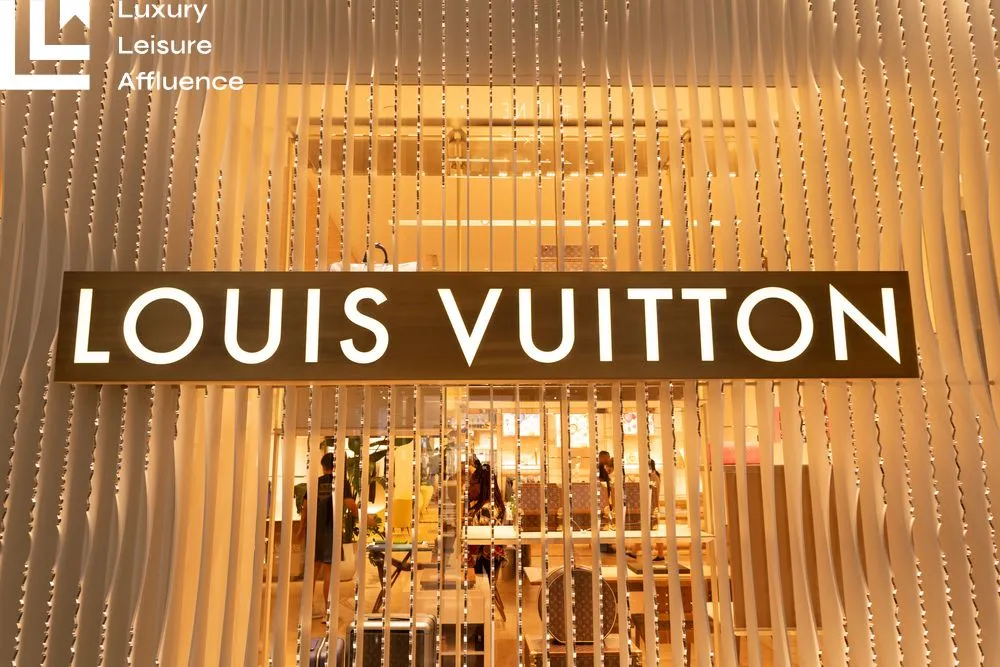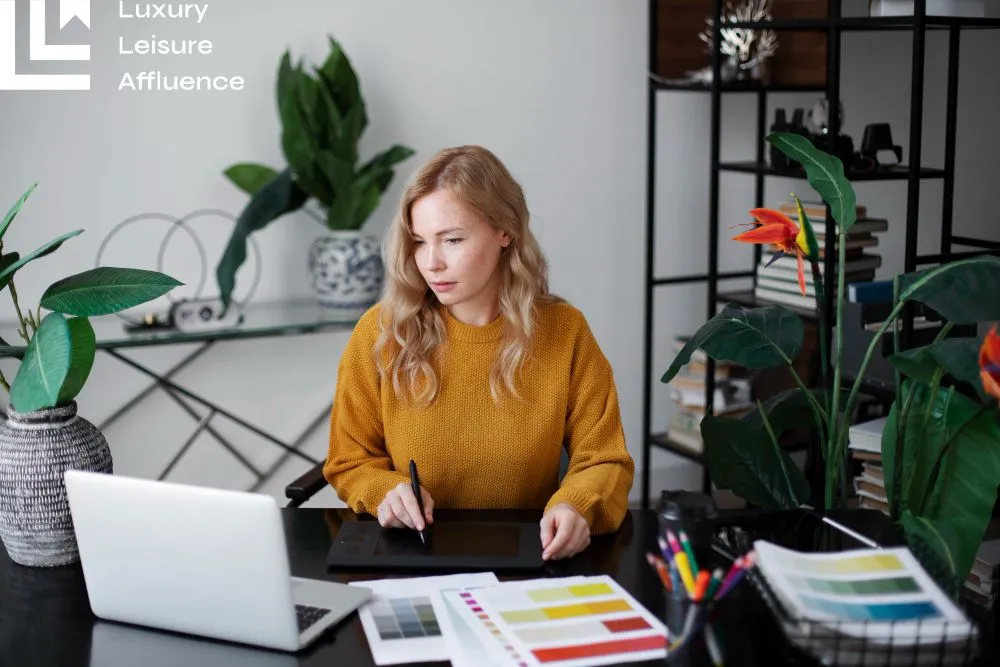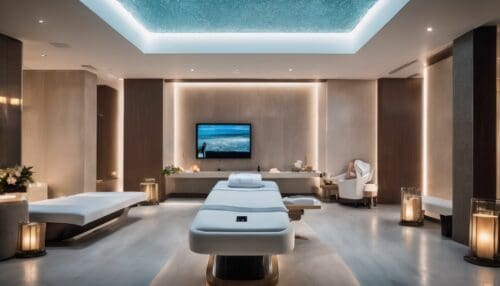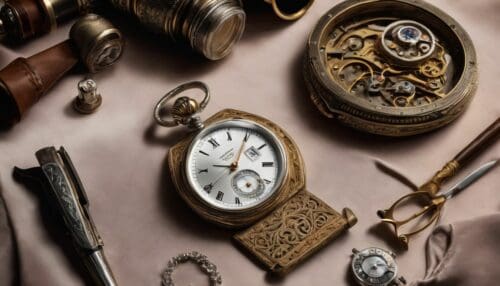Updated On: January 23, 2024 by Yasmin Elwan
Beyond the glimmer of diamonds and the whisper of silk, a distinct art form weaves its magic—luxury graphic design. More than just aesthetics, it’s a language of sophistication, a silent symphony of elegance that speaks to the discerning soul.
In this article, we embark on a curated exploration, delving into the essence of this captivating realm. From its storied past to its cutting-edge future, we’ll unveil the elements, techniques, and trends that elevate ordinary visuals into extraordinary experiences. Prepare to be captivated by the power of design that whispers “luxury” in every stroke, pixel, and texture.
Elements of Luxury Graphic Design
Luxury graphic design isn’t just about throwing gold glitter on anything and calling it a day. It’s a carefully crafted blend of elements that whisper exclusivity, evoke emotions, and tell a story of timeless elegance. Let’s dive into the key components that set these designs apart:
Typography

Imagine a world without Times New Roman. Now, picture a world where every brand speaks in its own bespoke typeface, a unique voice woven from lines and curves. That’s the power of custom fonts and lettering in luxury design. Take Chanel’s iconic interlocking Cs, for example, or Hermès’ refined serif font—each speaks volumes about the brand’s heritage and personality.
But it’s not just about custom. The choice between serif and sans-serif also plays a crucial role. Serif fonts like Garamond or Bodoni exude a sense of tradition and sophistication, while sans-serif fonts like Futura or Proxima Nova bring a sleek, modern edge.
- Tiffany & Co.: classic serif for a timeless jewellery brand
- Louis Vuitton: clean sans-serif for a fashion powerhouse with a global reach.
Colour Palette
Luxury isn’t about garish neon. It’s about evoking feelings of richness, depth, and refinement through colour. Think deep, saturated hues like burgundy, emerald green, and navy blue, often paired with accents of gold, silver, or black. Dolce & Gabbana’s vibrant yet opulent campaigns come to mind, while Cartier’s use of black and gold exudes timeless elegance.
But luxury also embraces subtlety. Muted tones, delicate gradients, and textured finishes can create a sense of understated luxury, as seen in the minimalist packaging of Brunello Cucinelli or the soft, pastel palettes of Dior.
Imagery and Illustration
Forget stock photos. Luxury design demands visuals that are as unique and exquisite as the products themselves. High-resolution photography showcasing craftsmanship and detail is a must, like the close-up shots of Rolex watches or the breathtaking landscapes in Patagonia’s marketing materials.
But luxury also embraces the power of illustration. Hand-drawn elements, intricate patterns, and bespoke artwork can add a touch of story and sophistication. Think of the whimsical illustrations in Gucci’s campaigns or the bold graphic patterns in Emilio Pucci’s designs.
Techniques and Trends
Beyond the core elements, luxury graphic design thrives on innovative techniques and cutting-edge trends that push the boundaries of visual storytelling. Let’s explore some of the key ways designers are crafting experiences that feel as exclusive as the products themselves:
Minimalism: Where Less is More
Luxury isn’t about excess; it’s about refinement. Minimalism reigns supreme in this realm, employing clean lines, negative space, and uncluttered layouts to create a sense of sophistication and exclusivity. Bottega Veneta’s stark designs and Celine’s focus on architectural form exemplify this trend beautifully.
This simplicity allows the focus to shift entirely to the product, drawing attention to its quality and craftsmanship. Think of the stark white backgrounds and single product shots in Apple’s marketing or the uncluttered packaging of Byredo’s perfumes.
Texture and Material Design: Feeling the Luxury
Visuals are just one part of the story. Luxury design engages all senses, and texture plays a crucial role. Embossing, debossing, and foil stamping add tactile elements that elevate the experience beyond the screen. Tom Ford’s sleek black packaging with embossed lettering is a prime example, as are Loewe’s textured paper cards.
But the luxury doesn’t stop at print. Digital platforms embrace material design, using realistic textures and shadows to create a sense of depth and dimensionality. The 3D product views on Dior’s website or the metallic finishes on Louis Vuitton’s app are perfect examples.
Digital vs. Print: Mastering the Medium
Luxury design isn’t confined to paper and ink. In today’s digital age, brands must tailor their visuals to each platform. Websites and apps become interactive showcases, while social media channels offer micro-moments of brand storytelling.
Consider Givenchy’s Instagram stories that transform products into animated narratives or Balmain’s website that offers VR experiences of their runway shows. The key is to understand the unique strengths of each medium and craft designs that resonate with the audience it reaches.
These are just a glimpse into the ever-evolving world of luxury graphic Design techniques and trends. By embracing innovation while staying true to core principles of elegance and exclusivity, brands can continue to push the boundaries and create experiences that truly evoke the essence of luxury.
Challenges and Considerations in Luxury Graphic Design
Crafting visuals that ooze exclusivity and resonate with discerning clients is no easy feat. Beyond the glitz and glamour, luxury graphic design faces unique challenges and considerations that demand careful navigation. Let’s explore some of the key hurdles designers must overcome to ensure their creations truly embody the essence of luxury:
Finding the Balance: Opulence vs. Simplicity
Luxury can be a double-edged sword. Bombarding viewers with excessive gold, diamantes, and intricate patterns can quickly veer into garishness. The true art lies in striking a delicate balance between opulence and simplicity. Think Tom Ford’s minimal packaging with its luxurious black and gold accents or Celine’s stark white backgrounds highlighting the impeccable tailoring of their garments.
Catering to a Diverse Canvas: Understanding Luxury Markets
Luxury isn’t monolithic. Cultural nuances, generational preferences, and regional variations demand a deep understanding of diverse target audiences. A design that speaks volumes to a seasoned Parisian collector might fall flat with a tech-savvy millennial in Tokyo. Research, cultural sensitivity, and tailoring visuals to resonate with specific demographics are crucial to achieving brand resonance in the global luxury landscape.
Keeping Pace with the Tides: Embracing Evolving Trends
Luxury shouldn’t be stagnant. While it cherishes heritage and timeless elegance, it must also embrace new technologies and evolving trends. Integrating elements of sustainability, ethical sourcing, and social responsibility into design narratives is becoming increasingly important for younger generations seeking conscious luxury. Staying ahead of the curve and incorporating elements of innovation without compromising core values is key to future-proofing luxury design.
The Psychology of Luxury Graphic Design
Luxury isn’t just a price tag; it’s a feeling. And in the realm of graphic design, this feeling is meticulously crafted, pixel by pixel, stroke by stroke. It’s about tapping into the deepest desires of the human psyche, using visual cues to trigger emotions, weave aspirations, and whisper promises of exclusivity. Let’s delve into the psychological magic that makes luxury graphic design tick:
The Allure of Scarcity
Humans are biologically wired to crave what’s rare. Limited editions, unique fonts, and bespoke packaging play on this innate desire making us feel privileged to own something not readily available. Picture a limited-edition fragrance campaign with only a handful of bottles beautifully captured in black and white, shrouded in an aura of mystery and exclusivity.
The Seduction of Status
Luxury designs speak volumes about who you are. Owning a product adorned with a recognisable brand logo, designed in a sophisticated typeface instantly elevates your perceived social standing. Think of the subtle gold lettering on a sleek black credit card, subtly implying financial prowess and privilege.
The Nostalgia Narrative
Luxury often taps into our yearning for a bygone era of craftsmanship and heritage. Vintage-inspired typography, sepia-toned visuals, and hand-drawn elements evoke a sense of timeless elegance and tradition. Imagine a perfume bottle housed in a box mimicking an antique book, transporting you to a world of old-world charm and allure.
The Power of Sensory Play
Luxury visuals extend beyond the visual cortex, engaging multiple senses. Embossed textures on packaging, metallic finishes on digital screens, and high-resolution visuals of tactile materials create a desire to reach out and touch, further immersing the viewer in the sensory experience.
The Whispers of Aspiration
Luxury design doesn’t just showcase products; it paints a picture of a desired lifestyle. Lavish imagery of idyllic locations, flawless models embodying effortless elegance, and aspirational product placements all tap into our dreams and desires, making us envision ourselves owning that piece of the high life.
By understanding these psychological levers, graphic designers can craft visuals that transcend mere aesthetics and tap into the very essence of what makes luxury so alluring. It’s a dance between desire and exclusivity, tradition and innovation, whispered promises and unspoken emotions. It’s this masterful manipulation of the human psyche that elevates graphic design from mere communication to a potent tool for shaping perception and driving the engine of luxury brands.
The Role of Technology in Luxury Graphic Design

Luxury graphic design has always been at the forefront of innovation, pushing boundaries and embracing new tools to elevate its storytelling and captivate audiences. But the digital revolution has ushered in a new era, where technology is no longer just a tool but a powerful partner in crafting the most immersive and exclusive experiences imaginable. Let’s explore how technology is transforming the landscape of luxury graphic design:
Augmented Reality (AR)
Imagine trying on a diamond necklace without stepping foot in a store or viewing a limited-edition watch from every angle in your living room. AR is blurring the lines between physical and digital, allowing brands to create interactive experiences that bring their products to life in a whole new way. Luxury fashion houses like Gucci and Dior are incorporating AR into their apps, showcasing their collections through virtual try-on features and immersive runway shows.
Virtual Reality (VR)
VR takes luxury experiences to a whole new level. Imagine stepping into a virtual boutique designed by Karl Lagerfeld or exploring the vineyards of a prestigious winemaker through a VR headset. Brands like Louis Vuitton and Balmain are using VR to create exclusive virtual experiences that transport customers into their brand universes, fostering deeper connections and emotional engagement.
Personalisation and Customisation
Luxury isn’t one-size-fits-all. Technology is allowing brands to personalise graphic design elements based on individual preferences. Imagine a website that dynamically changes its colour palette or typography based on your past browsing history or a product packaging that can be customised with your initials using AI-powered printing techniques. This level of personalisation creates a sense of exclusivity and caters to the growing demand for bespoke experiences.
Artificial Intelligence (AI)
AI is no longer just automating tasks; it’s becoming a creative collaborator in the world of luxury design. AI-powered tools can generate unique fonts, create custom artwork, and even personalise marketing messages based on real-time data. This opens up a world of possibilities for creating innovative and dynamic design experiences that resonate with individual customers.
The role of technology in luxury graphic design is far from static. As new technologies emerge and evolve, we can expect even more transformative experiences that redefine the boundaries of luxury and create deeper connections with discerning audiences.
The future of luxury graphic design is a blank canvas, waiting to be splashed with the colours of innovation, sustainability, and personalisation. It’s a call to action for designers to break free from the shackles of convention and embrace the power of technology while respecting the heritage of craftsmanship.











